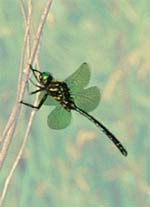
 |
||
 |
||
 |
Scientists also study the species' life cycle to determine how the environment affects an animal at each stage of its growth. Zoologists hope that their studies will tell them why a species thrives in certain places.
Genetic Variability
In some cases, scientists may attempt to determine the genetic variability in the population of a species at the different locations where it is found. If the genetic variability is very low in an area, then the population may not be able to adapt to changes and may be in danger of disappearing. They also conduct surveys to find and describe additional populations. All of this information gives us an idea of how we can sustain populations and help them to increase through habitat management.
Once we know more about a species' population and habitat, we can make intelligent decisions about how to begin protecting or restoring habitats. For animals such as the Hine's emerald dragonfly, this means protecting headwaters of streams and managing vegetation. Protection of aquatic environments is essential to the survival of the larvae of this dragonfly. Survival of the larvae is critical to the survival of the dragonfly.
The Hine's emerald dragonfly was put on the state endangered species list in Illinois in 1991 and the federal endangered species list in 1995. This protected the Hine's dragonfly by prohibiting its collection from the wild except by special permit.
 When
a plant or animal is placed on the federal endangered species list, then
an appointed "recovery team" must prepare and submit a recovery plan to
the United States Fish and Wildlife Service. A number of experts in the
field agree to serve on the recovery team and decide what is the best
way to develop a plan to recover the species (or whether or not it can
be recovered). Whether through management or recovery of populations,
the ultimate goal is to improve conditions so that the species can eventually
be removed from the endangered species list. A recovery plan includes
information on the minimum number and size of populations that would be
needed to sustain the species indefinitely. Museum zoologists are working
on the recovery plan for the Hine's emerald dragonfly.
When
a plant or animal is placed on the federal endangered species list, then
an appointed "recovery team" must prepare and submit a recovery plan to
the United States Fish and Wildlife Service. A number of experts in the
field agree to serve on the recovery team and decide what is the best
way to develop a plan to recover the species (or whether or not it can
be recovered). Whether through management or recovery of populations,
the ultimate goal is to improve conditions so that the species can eventually
be removed from the endangered species list. A recovery plan includes
information on the minimum number and size of populations that would be
needed to sustain the species indefinitely. Museum zoologists are working
on the recovery plan for the Hine's emerald dragonfly.
|
|
Copyright© 2000 Illinois State Museum Society